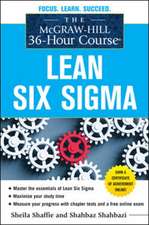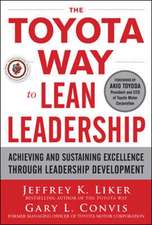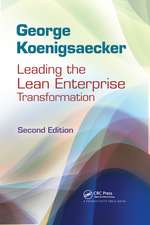Six Sigma for Organizational Excellence: A Statistical Approach
Autor K. Muralidharanen Limba Engleză Hardback – 11 mai 2015
To aid in understanding, the book includes a wealth of tables, graphs, descriptions and checklists, as well as charts and plots, worked-out examples and exercises. Perhaps the most unique feature of the book is its approach, using statistical tools, to explain the science behind Six Sigma project management and integrated in engineering concepts. The material on quality engineering and statistical management tools offers valuable support for undergraduate, postgraduate and research students. The book can also serve as a concise guide for Six Sigma professionals, Green Belt, Black Belt and Master Black Belt trainers.
| Toate formatele și edițiile | Preț | Express |
|---|---|---|
| Paperback (1) | 408.37 lei 6-8 săpt. | |
| Springer India – 23 oct 2016 | 408.37 lei 6-8 săpt. | |
| Hardback (1) | 416.05 lei 6-8 săpt. | |
| Springer India – 11 mai 2015 | 416.05 lei 6-8 săpt. |
Preț: 416.05 lei
Nou
Puncte Express: 624
Preț estimativ în valută:
79.62€ • 82.25$ • 66.26£
79.62€ • 82.25$ • 66.26£
Carte tipărită la comandă
Livrare economică 25 martie-08 aprilie
Preluare comenzi: 021 569.72.76
Specificații
ISBN-13: 9788132223245
ISBN-10: 8132223241
Pagini: 569
Ilustrații: XXIV, 622 p. 141 illus.
Dimensiuni: 155 x 235 x 40 mm
Greutate: 1.08 kg
Ediția:2015
Editura: Springer India
Colecția Springer
Locul publicării:New Delhi, India
ISBN-10: 8132223241
Pagini: 569
Ilustrații: XXIV, 622 p. 141 illus.
Dimensiuni: 155 x 235 x 40 mm
Greutate: 1.08 kg
Ediția:2015
Editura: Springer India
Colecția Springer
Locul publicării:New Delhi, India
Public țintă
GraduateCuprins
Chapter 1. Six Sigma Concepts.- Chapter 2. Six Sigma Project Management.-Chapter 3. Six Sigma Process.- Chapter 4. Understanding Variation.- Chapter 5. Sigma Estimation.- Chapter 6. Sample Size Determination.- Chapter 7. Define Phase.- Chapter 8. Measure Phase.- Chapter 9. Analyze Phase.- Chapter 10. Improve Phase.- Chapter 11. Control Phase.- Chapter 12. Sigma Level Estimation.- Chapter 13. Continuous Improvement.- Chapter 14. Six Sigma Marketing.- Chapter 15. Green Six Sigma.- Chapter 16. Six Sigma: Some Pros and Cons.- Chapter 17. Six Sigma: Some case studies.
Recenzii
“The book in fact is a mix of project management, statistics, and Six Sigma topics. … The strength of the book is the fact that it builds a very strong bridge between statistics discipline and Six Sigma. The target audience is project managers and Information Technology professional and also students in management and related disciplines. The book would have enough material for a 1 year long course if it is selected as a textbook.” (Morteza Marzjarani, Technometrics, Vol. 58 (3), August, 2016)
Notă biografică
K. Muralidharan is professor and head of the Department of Statistics, Faculty of Science, Maharajah Sayajirao University of Baroda, Vadodara. In addition to being the director of the Population Research Centre of this university, Professor Muralidharan is also an adjunct faculty at Indian Institute of Technology Gandhinagar, India. He did post-doctoral fellowship from the Institute of Statistical Science, Academia Sinica, Taiwan. He is an internationally certified Six Sigma Master Black Belt from Indian Statistical Institute, Bangalore.
Textul de pe ultima copertă
This book discusses the integrated concepts of statistical quality engineering and management tools. It will help readers to understand and apply the concepts of quality through project management and technical analysis, using statistical methods. Prepared in a ready-to-use form, the text will equip practitioners to implement the Six Sigma principles in projects. The concepts discussed are all critically assessed and explained, allowing them to be practically applied in managerial decision-making, and in each chapter, the objectives and connections to the rest of the work are clearly illustrated.
To aid in understanding, the book includes a wealth of tables, graphs, descriptions and checklists, as well as charts and plots, worked-out examples and exercises. Perhaps the most unique feature of the book is its approach, using statistical tools, to explain the science behind Six Sigma project management and integrated in engineering concepts. The material on quality engineering and statistical management tools offers valuable support for undergraduate, postgraduate and research students. The book can also serve as a concise guide for Six Sigma professionals, Green Belt, Black Belt and Master Black Belt trainers.
To aid in understanding, the book includes a wealth of tables, graphs, descriptions and checklists, as well as charts and plots, worked-out examples and exercises. Perhaps the most unique feature of the book is its approach, using statistical tools, to explain the science behind Six Sigma project management and integrated in engineering concepts. The material on quality engineering and statistical management tools offers valuable support for undergraduate, postgraduate and research students. The book can also serve as a concise guide for Six Sigma professionals, Green Belt, Black Belt and Master Black Belt trainers.
Caracteristici
Broadens readers’ understanding of quality engineering and management tools of statistics Demonstrates the Six Sigma project management approach, integrated through engineering concepts Integrates three main disciplines—Science, Engineering and Management—to study the Six Sigma concepts Serves as a concise user’s guide for Six Sigma professionals, Green Belt, Black Belt and Master Black Belt trainers Serves as a textbook and a reference material for students in the fields of Science, Engineering and Management Includes supplementary material: sn.pub/extras












